2007: Across the Line
OCTOBER 2007:
THE FIRST PRESIDENT TO CROSS THE MILITARY DEMARCATION LINE (MDL) FOR THE INTER-KOREAN SUMMIT
“We will commit ourselves to ensuring that this step leads to peace and prosperity.”
October 2–4, 2007
In 2007, seven years after the 2000 Summit,
the second Inter-Korean Summit was held in Pyeongyang.
President Roh Moo-hyun and Chairman Kim Jong Il meet for the first time at the welcoming ceremony in front of the April 25 House of Culture Plaza, Pyeongyang
On October 2, 2007, the whole world watched as President Roh Moo-hyun crossed the MDL for the second Inter-Korean Summit. President Roh became the first president to cross the forbidden line that evidences the division of the Korean Peninsula.
-
2nd
President Roh Moo-hyun
arriving in North Korea -
3rd
President Roh Moo-hyun
and Chairman Kim Jong Il sitting
for the Inter-Korean Summit -
4th
Adoption and announcement
of the Declaration
on the Advancement
of South–North Korean Relations,
Peace, and Prosperity
The footsteps of peacein three days
-
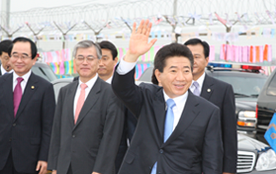
President Roh Moo-hyun waving at citizens at the send-off ceremony for a delegation to North Korea held at the southern end of the Tongildaegyo Bridge, Paju
-
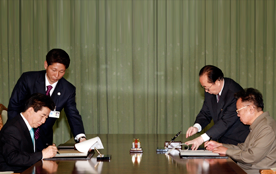
President Roh Moo-hyun and Chairman Kim Jong Il signing the South-North Joint Declaration.
-
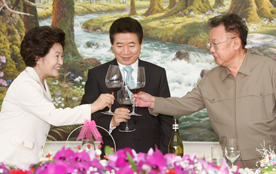
President Roh Moo-hyun and the First Lady and Chairman Kim Jong Il sharing a toast at the farewell lunch held at Yeongbingwan, Baekhwawon
-
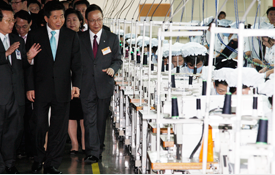
President Roh Moo-hyun visiting an industrial site in the Gaeseong Industrial Complex on his way to South Korea
“I cross this forbidden line as a president. This step today will be followed by many others in days to come. The many steps will gradually erase this forbidden line. The wall will fall.
President Roh Moo-hyun immediately before crossing the MDL (October 2, 2007)“Above all, this year’s summit once again reminded me of the importance of trust. I was able to reaffirm the fact that respecting each other and trying to understand each other from the other’s perspective is the royal road to bringing down the wall of distrust.”
President Roh Moo-hyun’s speech during the return banquet (October 3, 2007)“I believe we achieved great outcomes, so much so that I could not fit them all in the bag that I had brought with me for the summit.”
President Roh Moo-hyun’s public message (October 4, 2007)The Key Elements of the Declaration
on the Advancement of South–North Korean Relations, Peace, and Prosperity
In the summit, President Roh Moo-hyun and Chairman of the National Defense Commission Kim Jong Il affirmed their shared understanding of the need to end the current armistice regime and build a permanent peace regime. To this end, the two leaders agreed to work toward having the leaders of the three or four parties directly concerned to convene on the Peninsula and declare an end to the Korean War. The two sides also agreed to carry out joint programs across various fields including politics, military, economy, society, and culture. The two leaders set forth these agreements in the Declaration on the Advancement of South–North Korean Relations, Peace, and Prosperity.
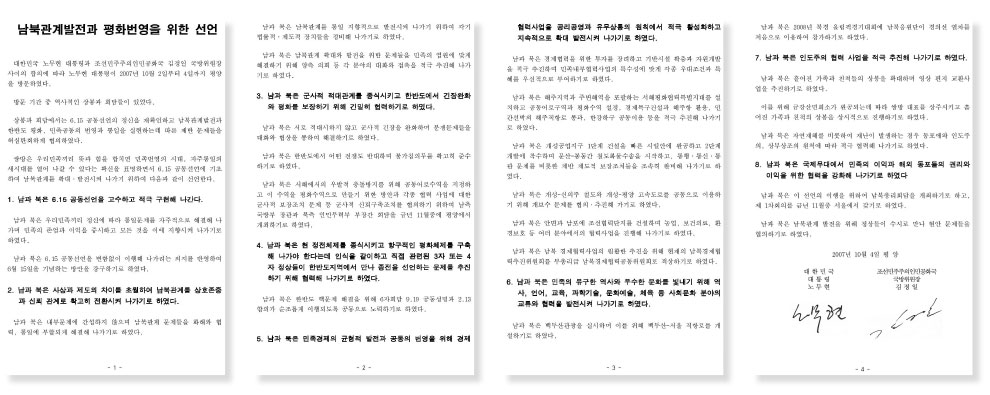 Source: Roh Moo-hyun Foundation (Foundation News)
Source: Roh Moo-hyun Foundation (Foundation News)
- Peace on the Korean Peninsula
- Work toward a three- or four-party talk to declare an end to the Korean War
- Implement the September 19 Joint Statement and the February 13 Agreement
- Designate a joint fishing area in the West Sea and turn it into a peace zone
- Hold talks between the South’s Minister of Defense and the North’s Minister of the People’s Armed Forces
- Common Prosperity of the Korean People
- Create a special peace and cooperation zone in the West Sea
- Jointly use the Han River estuary
- Establish cooperative complexes for shipbuilding in Anbyeon and Nampo
- Resolve the passage, communication, and customs issues for the Gaeseong Industrial Complex
- Open freight rail services on Gyeongui Railway Line between Munsan and Bongdong
- Reconciliation and Unification
- Hold frequent talks
- Hold the First Inter-Korean Prime Ministers’ Talk
- Extend the reunion of separated family members and relatives and promote video message exchanges
- Open tours to Mt. Baekdu and open nonstop flight services between Seoul and Mt. Baekdu
- Send a joint cheering squad to the 2008 Beijing Olympic Games on the Gyeongui Railway Line
Significance of the 2007 Summit
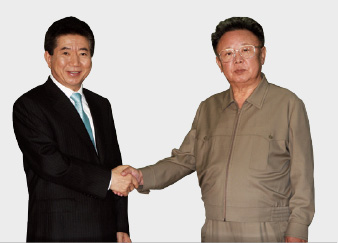
In particular, the 2007 Summit set off discussions on the issues regarding the military and the peace regime that the two Koreas had not been able to discuss in earnest. The two leaders reaffirmed their commitment to the peaceful denuclearization of the Korean Peninsula and agreed to work together toward their goals. They also shared the understanding that the peace on the Korean Peninsula is the only way to achieve the common prosperity of the Korean people, as well as peace and prosperity of the entire Northeast Asian region.
The summit also holds a historical significance—President Roh Moo-hyun became the first South Korean leader to cross the MDL on foot since the division of the Korean Peninsula. This gesture served as an international declaration of the hope of the Korean people to overcome the wall of division and conflict to achieve peace and prosperity.
“I will do my best to fulfill this responsibility bestowed upon me based on an objective assessment of the circumstances that surround us today.”
President Roh Moo-hyun’s public message before his departure for Pyeongyang (October 2, 2007)